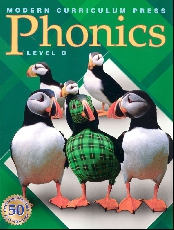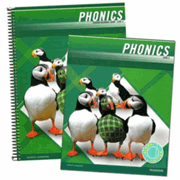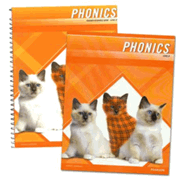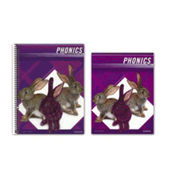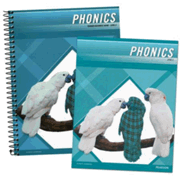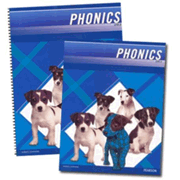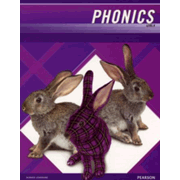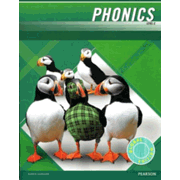The MCP Plaid Phonics workbooks have been staples in the homeschool world for at least 30 years. MCP (Modern Curriculum Press) was taken over by Pearson Education, Inc. some years ago. Because of that change, this series has been relabeled with the simple title Phonics. The only remaining reminders that is was originally the “plaid” series are hints on the covers such as the plaid patterns on the penguins pictured on the cover to the left and a hint of a plaid background. Despite these cosmetic changes, the insides of the books remain almost identical to those of the 2003 MCP editions.
These Phonics worktexts can be used for phonics instruction or reinforcement, although most homeschoolers use them as workbook supplements to other phonics programs.
They are colorfully illustrated with a combination of photographs and drawings. Some illustrations were commissioned from children’s book illustrators. The variety of activities and colorful presentation make these workbooks appealing to children, and large print reduces the intimidation factor.
Their primary use is to help children develop both auditory and visual discrimination of sounds and letters. In the first three books, children do many exercises on recognition of beginning, ending, and middle sounds or phonograms.
Over the years, this series has changed, adding some features from the whole language approach to reading. Thus, the newest books (especially Levels B and C) include short stories and comprehension activities, make-it-yourself little storybooks, composition activities, and a “less-controlled” vocabulary. Unit openers are either a nonfiction reading passage related to science or social studies, or a poem. Other whole language activities (e.g., suggestions for related story books to read aloud) are in the teacher’s resource guide.
Generally, these are positive improvements because the old editions repeated essentially the same information year after year. Level C reflects these changes the most. It reviews basic phonetic concepts within a variety of exercises then goes on to extensive work with base words, prefixes, suffixes, plurals, syllables, synonyms, antonyms, homonyms, dictionary skills, and a few composition activities.
Level K introduces letters and sounds (both short and long vowels), working on identification and discrimination of individual letters. It includes a set of color flash cards in the back of the student book. Level A reviews, then adds long vowels, blends, digraphs, contractions, and inflectional endings. Level B reviews more rapidly, then adds compound and two-syllable words, R-controlled vowels, vowel pairs and digraphs, diphthongs, and contractions. The final section introduces synonyms, antonyms, homonyms, and some prefixes.
In the last few editions of this series, high-frequency words get more attention. There are word cards at the back of student books for levels K, A and B in addition to more work on such words throughout the entire series.
While Plaid Phonics could theoretically be used as your primary phonics instruction resource, it might not spend as much time as most children need on the critical blending stage. For example, most intensive phonics programs will have children spend a good deal of time working with word family groups like “at, sat, pat, hat, mat” to develop familiarity with the “at” phonogram. In Plaid Phonics, some work on blending is taught directly from the Teacher Resource Guides, so if you want to use this as your primary tool, you will definitely need to purchase and use the Guides, taking as much time as needed to work through the blending stage.
Teacher Resource Guides offer this sort of lesson-expanding help as well as lesson presentation instructions and workbook answers. However, if you only want to use Plaid Phonics as a supplement, you probably do not need the Guides. Workbook activities have clear instructions and answers are fairly obvious. Also, much of each guide’s content is classroom oriented and unlikely to be used by many home educators. I suspect many homeschoolers purchase Plaid Phonics workbooks just because they are so easy to use without teacher guides as well as for the fact that their children enjoy them.
Levels D, E, and F are also available, but they focus on word study, thinking, comprehension, and composition skills rather than phonics.




